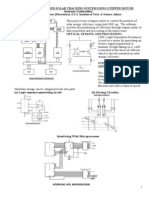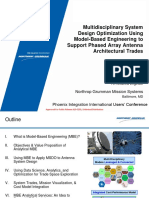0 ratings0% found this document useful (0 votes)
56 viewsMSI Presentation
MSI Presentation
Uploaded by
abdullahThis document describes a student project to create a coffee machine using a PIC18F452 microcontroller. It includes sections on introduction, literature review, methodology, results, teamwork/task division, societal impact, environmental impact, learning, and conclusion. The coffee machine allows orders to be placed through buttons and displays results on an LCD screen. The project was completed through teamwork and involved programming the microcontroller in assembly language, simulating in Proteus, and implementing the hardware.
Copyright:
© All Rights Reserved
Available Formats
Download as PPTX, PDF, TXT or read online from Scribd
MSI Presentation
MSI Presentation
Uploaded by
abdullah0 ratings0% found this document useful (0 votes)
56 views12 pagesThis document describes a student project to create a coffee machine using a PIC18F452 microcontroller. It includes sections on introduction, literature review, methodology, results, teamwork/task division, societal impact, environmental impact, learning, and conclusion. The coffee machine allows orders to be placed through buttons and displays results on an LCD screen. The project was completed through teamwork and involved programming the microcontroller in assembly language, simulating in Proteus, and implementing the hardware.
Original Description:
msi
Copyright
© © All Rights Reserved
Available Formats
PPTX, PDF, TXT or read online from Scribd
Share this document
Did you find this document useful?
Is this content inappropriate?
This document describes a student project to create a coffee machine using a PIC18F452 microcontroller. It includes sections on introduction, literature review, methodology, results, teamwork/task division, societal impact, environmental impact, learning, and conclusion. The coffee machine allows orders to be placed through buttons and displays results on an LCD screen. The project was completed through teamwork and involved programming the microcontroller in assembly language, simulating in Proteus, and implementing the hardware.
Copyright:
© All Rights Reserved
Available Formats
Download as PPTX, PDF, TXT or read online from Scribd
Download as pptx, pdf, or txt
0 ratings0% found this document useful (0 votes)
56 views12 pagesMSI Presentation
MSI Presentation
Uploaded by
abdullahThis document describes a student project to create a coffee machine using a PIC18F452 microcontroller. It includes sections on introduction, literature review, methodology, results, teamwork/task division, societal impact, environmental impact, learning, and conclusion. The coffee machine allows orders to be placed through buttons and displays results on an LCD screen. The project was completed through teamwork and involved programming the microcontroller in assembly language, simulating in Proteus, and implementing the hardware.
Copyright:
© All Rights Reserved
Available Formats
Download as PPTX, PDF, TXT or read online from Scribd
Download as pptx, pdf, or txt
You are on page 1of 12
COFFEE MACHINE
Name: Muhammad Hamza Shaukat Reg # FA19-EPE-009
Name: Asim Khan Reg # FA19-EPE-035
Name: Abdullah Reg # FA20-EPE-002
Supervisor: Sir Muhammad Naveed Shaikh
Department of Computer and Electrical Engineering
CUI, ATD
Project Outline
Introduction
Literature Review
Methodology
Results
Teamwork/Task Division
Societal Impact
Environmental Impact
Learning
Conclusion
Department of Computer and Electrical Engineering
CUI, ATD
Introduction
Coffee maker machine using PIC18F452 microcontroller
The results is displayed in LCD (16x2)
For Assembly code MPLAB is used
LCD and microcontroller are interfaced through assembly
language
Overall logic is developed in order to meet the
requirements of our task
The system can be used for many orders continously
Department of Computer and Electrical Engineering
CUI, ATD
Literature Review
One should be have past information about LCD
programming, circling and exchanging structure.
By following the course concepts, we have successfully
complete our project
Following concepts are mandatory for cep solution:
a).assembly language coding
b).proteus simulation
c).code burning into PIC18F452
d).Hardware implementation
Department of Computer and Electrical Engineering
CUI, ATD
Methodology
Obtain the task with microcontroller
For displaying of results, we used LCD
The overall system can be controlled with
switchs RBO as a cup RB1 as a water level and
RB2 as a coffee powder
Works on 5v voltage supply
Implemented the whole circuit on breadboard
Push botton and to show your coffee is prepared
Department of Computer and Electrical Engineering
CUI, ATD
Block Diagram
Department of Computer and Electrical Engineering
CUI, ATD
Results
The PIC18F452 microcontroller is programed
with MPLAB coding
The microcontroller and LCD is properly
interfaced
The idea successfully worked and the results is
displayed in proteus
Input and output configuration in order to take
order is working properly
Department of Computer and Electrical Engineering CUI,
ATD
Simulation Results
Department of Computer and Electrical Engineering CUI,
ATD
Teamwork/ Tasks division
Perform the whole project with teamwork
Discussed it at every step
Divided different tasks for better understanding
Hardware implementation(Teamwork)
Report making(Teamwork)
Presentations and slides(Teamwork)
Data Research
Implementing different ideas
Department of Computer and Electrical Engineering CUI,
ATD
Societal Impact
Department of Computer and Electrical Engineering CUI,
ATD
Environmental Impact
The PIC18F452 microcontroller is a low power device,
which means it can operate with relatively low power
consumption. This can be beneficial for a coffee
machine that is intended to be powered by batteries or
other energy-limited sources.
It helps to automate the system and work with 1touch.
Easy acces to use and troubleshoot the fault without
wasting time.
Department of Computer and Electrical Engineering CUI,
ATD
Conclusion
Used microcontroller for the first time
Understand all the works and principles of
microcontroller in details
Learn about assembly language
Interfaced the LCD with PIC18F452
Implemented the logic in both software and
hardware and achieved the required task
Department of Computer and Electrical Engineering
CUI, ATD
You might also like
- White Paper My SAP ERP CGMPDocument44 pagesWhite Paper My SAP ERP CGMPfurqan.malik100% (1)
- LED Matrix Display Project ReportDocument81 pagesLED Matrix Display Project ReportAmar Shrestha81% (16)
- PLC Programming from Novice to Professional: Learn PLC Programming with Training VideosFrom EverandPLC Programming from Novice to Professional: Learn PLC Programming with Training VideosRating: 5 out of 5 stars5/5 (1)
- 05Document42 pages05tt_aljobory3911No ratings yet
- AGV Project ReportDocument46 pagesAGV Project ReportPratheesh Pala100% (7)
- Ic Tester ReportDocument46 pagesIc Tester Reportsajid_mllNo ratings yet
- Digital Ic TesterDocument44 pagesDigital Ic TesterSri Abhimanyu SystemsNo ratings yet
- Institute of Civil and Rural Engineering (Aided) : Basic of PLC Data Sheet of Various ManufacturersDocument13 pagesInstitute of Civil and Rural Engineering (Aided) : Basic of PLC Data Sheet of Various ManufacturersPranil KambleNo ratings yet
- New PLC Lab Manual2 Compressed (1) 1650437778Document66 pagesNew PLC Lab Manual2 Compressed (1) 1650437778sureshgurujiNo ratings yet
- Arabic Course - 12 - AppendixDocument6 pagesArabic Course - 12 - AppendixadeelNo ratings yet
- Lab 1-4 - ReportsDocument29 pagesLab 1-4 - ReportsArslan ShafiNo ratings yet
- Low Cost Computerized Digital IC TesterDocument4 pagesLow Cost Computerized Digital IC Testereditor_ijtelNo ratings yet
- Item Reference Description Qty.: PLC S Module Ref: 0921/PLCDocument2 pagesItem Reference Description Qty.: PLC S Module Ref: 0921/PLCA94leo14hsetmaNo ratings yet
- Digital Computer Technology Progress ReportDocument4 pagesDigital Computer Technology Progress ReportSusan AlabiNo ratings yet
- MMI - Lab Manual-2024Document23 pagesMMI - Lab Manual-2024shwerghu2003No ratings yet
- Solar Track1 51Document7 pagesSolar Track1 51Srinivasa Reddy Devi ReddyNo ratings yet
- Raghu ReportDocument42 pagesRaghu ReportTyrone MichaelsNo ratings yet
- LAB3 EmbeddedDocument4 pagesLAB3 Embeddedmijeje93No ratings yet
- Grp03 Blinking MiniprojectDocument3 pagesGrp03 Blinking MiniprojectYasin OmaryNo ratings yet
- Design and Implementation of Electronic Control Trainer With PIC MicrocontrollerDocument7 pagesDesign and Implementation of Electronic Control Trainer With PIC Microcontrolleryousif al mashhadanyNo ratings yet
- Item Reference Description Qty.: PLC S Module Ref: 0920/PLCDocument2 pagesItem Reference Description Qty.: PLC S Module Ref: 0920/PLCA94leo14hsetmaNo ratings yet
- Project Title: Wireless Voting Machine With Touch ScreenDocument24 pagesProject Title: Wireless Voting Machine With Touch Screenfida ullahNo ratings yet
- Item Reference Description Qty.: PLC S Module Ref: 0940/PLCDocument2 pagesItem Reference Description Qty.: PLC S Module Ref: 0940/PLCA94leo14hsetmaNo ratings yet
- Ensino Training Report NaveenDocument43 pagesEnsino Training Report NaveenluckygehlotpicNo ratings yet
- Item Reference Description Qty.: PLC S Module Ref: 0931/PLCDocument2 pagesItem Reference Description Qty.: PLC S Module Ref: 0931/PLCA94leo14hsetmaNo ratings yet
- PTK40A Training Kit: User Manual V2.0 August 2014Document88 pagesPTK40A Training Kit: User Manual V2.0 August 2014Mahayudin Saad100% (1)
- Mikroprog Pic Manual v200Document44 pagesMikroprog Pic Manual v200kica62100% (1)
- Microcontroller Ab Manual NewDocument57 pagesMicrocontroller Ab Manual NewshilpaNo ratings yet
- PTK40A MPLABHT Examples GuideDocument87 pagesPTK40A MPLABHT Examples GuideMahayudin SaadNo ratings yet
- Project ProposalDocument5 pagesProject ProposalEric OduorNo ratings yet
- MSI FinalDocument14 pagesMSI FinalabdullahNo ratings yet
- CP323L - Experiment 1Document6 pagesCP323L - Experiment 12101249No ratings yet
- Ee-328-F Microcontroller&Embeded System Design LABDocument1 pageEe-328-F Microcontroller&Embeded System Design LABsweety_1No ratings yet
- Design of PLC Using Arduino UNO: A Capstone Project ReportDocument57 pagesDesign of PLC Using Arduino UNO: A Capstone Project ReportSawan SoniNo ratings yet
- DMC6312 - Internet of Things LaboratoryDocument47 pagesDMC6312 - Internet of Things LaboratoryharishNo ratings yet
- PLC & SCADA Training ReportDocument44 pagesPLC & SCADA Training Reportneeraj meena100% (2)
- Task-3.1 DDocument4 pagesTask-3.1 DDikshant MahajanNo ratings yet
- Repot On Picmicrocontroller PDFDocument54 pagesRepot On Picmicrocontroller PDFSafwan MohamedNo ratings yet
- Complete Adv PLC Simatic 06-02-14 CoverDocument215 pagesComplete Adv PLC Simatic 06-02-14 Coversvhanu4010No ratings yet
- Sk40c Pic 16f877a Crash CourseDocument24 pagesSk40c Pic 16f877a Crash Coursezulko100% (3)
- VLSI & Embedded Systems Lab ManualDocument137 pagesVLSI & Embedded Systems Lab Manualganga avinash reddyNo ratings yet
- IV Ansar OrgDocument50 pagesIV Ansar OrgAbhin AsNo ratings yet
- User-Manual 2 SK 40 CDocument64 pagesUser-Manual 2 SK 40 CRex Alvin FrancisNo ratings yet
- RS232 Communication Using PIC18F4520 S USART PIC Micro Controller Tutorial Extreme ElectronicsDocument24 pagesRS232 Communication Using PIC18F4520 S USART PIC Micro Controller Tutorial Extreme ElectronicsHectorLopez100% (1)
- An Introduction To Programming The Microchip PIC in CDocument162 pagesAn Introduction To Programming The Microchip PIC in Cagg_mayur1100% (8)
- Z80 Assembly Language Programming Manual (1977) - Zilog IncDocument21 pagesZ80 Assembly Language Programming Manual (1977) - Zilog IncJaime BarraganNo ratings yet
- LjusevDocument6 pagesLjusevrute silvaNo ratings yet
- Pipelined ADC ThesisDocument54 pagesPipelined ADC ThesisHarshita MehtonNo ratings yet
- Moving Message Display: Guided ByDocument15 pagesMoving Message Display: Guided ByArpan DesaiNo ratings yet
- Digital Energy MeterDocument3 pagesDigital Energy MeterbapoonprdNo ratings yet
- FINAL NiveditaDocument37 pagesFINAL NiveditaEr Prathma MittalNo ratings yet
- ES Lab Manual DSP Board-EmbeddedDocument77 pagesES Lab Manual DSP Board-EmbeddedemillianoNo ratings yet
- C Programming for the Pc the Mac and the Arduino Microcontroller SystemFrom EverandC Programming for the Pc the Mac and the Arduino Microcontroller SystemNo ratings yet
- C Programming for the PIC Microcontroller: Demystify Coding with Embedded ProgrammingFrom EverandC Programming for the PIC Microcontroller: Demystify Coding with Embedded ProgrammingNo ratings yet
- Intermediate C Programming for the PIC Microcontroller: Simplifying Embedded ProgrammingFrom EverandIntermediate C Programming for the PIC Microcontroller: Simplifying Embedded ProgrammingNo ratings yet
- FPGA Programming for Beginners: Bring your ideas to life by creating hardware designs and electronic circuits with SystemVerilogFrom EverandFPGA Programming for Beginners: Bring your ideas to life by creating hardware designs and electronic circuits with SystemVerilogNo ratings yet
- Psoc Ass 1Document8 pagesPsoc Ass 1abdullahNo ratings yet
- Assignment No 1Document3 pagesAssignment No 1abdullahNo ratings yet
- Coffee MachineDocument21 pagesCoffee MachineabdullahNo ratings yet
- MSI FinalDocument14 pagesMSI FinalabdullahNo ratings yet
- MSI NotesDocument37 pagesMSI NotesabdullahNo ratings yet
- Assignment 3Document13 pagesAssignment 3abdullahNo ratings yet
- GPON Troubleshooting CommandsDocument7 pagesGPON Troubleshooting CommandsPrabhashKumarJhaNo ratings yet
- Human Factors-Systems Engineering and Analysis by Blanchard and FabryckyDocument1 pageHuman Factors-Systems Engineering and Analysis by Blanchard and FabryckyBianca TimofteNo ratings yet
- Resetting PowerBook and Ibook Power Management Unit (PMU)Document5 pagesResetting PowerBook and Ibook Power Management Unit (PMU)youhou_houNo ratings yet
- Tri-Modal Technique For Medical Images EnhancementDocument12 pagesTri-Modal Technique For Medical Images EnhancementInternational Journal of Advances in Applied Sciences (IJAAS)No ratings yet
- User'S Manual: Pneumatic Positioner YT-1200 SeriesDocument22 pagesUser'S Manual: Pneumatic Positioner YT-1200 SeriescesarNo ratings yet
- Te D275ax-5Document16 pagesTe D275ax-5Copemaq CopemaqNo ratings yet
- Phx2018UC MDAO Northrop-Grumman HodgeDocument32 pagesPhx2018UC MDAO Northrop-Grumman HodgeMohan Babu ANo ratings yet
- ES QuizDocument85 pagesES QuizVenkat Chowdary Yamparala100% (3)
- Hfe Sony Str-Da30es Da50es V55es ServiceDocument16 pagesHfe Sony Str-Da30es Da50es V55es ServiceFeisal Ali100% (1)
- FSSAI CertificateDocument4 pagesFSSAI CertificateaksinhaNo ratings yet
- BS Iso 02219-2010Document34 pagesBS Iso 02219-2010Ahmed SalehNo ratings yet
- Capacity Management 3GDocument15 pagesCapacity Management 3GAndikaParamesthiNo ratings yet
- What Is .ART File ViewerDocument4 pagesWhat Is .ART File ViewerjackNo ratings yet
- Emulate Rslogix5000Document60 pagesEmulate Rslogix5000simplementemoiNo ratings yet
- Cyber-Physical Systems: Alla G. Kravets Alexander A. Bolshakov Maxim V. Shcherbakov EditorsDocument389 pagesCyber-Physical Systems: Alla G. Kravets Alexander A. Bolshakov Maxim V. Shcherbakov EditorsPul50100% (1)
- Automatic Vehicle Accident Detection and Messageing System IJERTCONV4IS11034Document3 pagesAutomatic Vehicle Accident Detection and Messageing System IJERTCONV4IS11034sireesha payyavulaNo ratings yet
- Component Tests: Insulation Test SystemDocument12 pagesComponent Tests: Insulation Test System1382aceNo ratings yet
- Assignement No. 4 (MCP)Document7 pagesAssignement No. 4 (MCP)Shahrooz WaleedNo ratings yet
- APM PSRAM QSPI APS6404L SQN v3 6 PKG-1954836Document25 pagesAPM PSRAM QSPI APS6404L SQN v3 6 PKG-1954836ManunoghiNo ratings yet
- Comparison and Assessment of Using Primavera and Microsoft Project in Construction Projects in Erbil CityDocument8 pagesComparison and Assessment of Using Primavera and Microsoft Project in Construction Projects in Erbil CitybrinthamrNo ratings yet
- Conexiones EstablecidasDocument4 pagesConexiones EstablecidasRicardo Alejandro PedriqueNo ratings yet
- وزاري انكلش وحلوله - عباسDocument20 pagesوزاري انكلش وحلوله - عباسAhmedA.HassanNo ratings yet
- Rencana Anggaran Biaya Pembangunan Jaringan KomputerDocument4 pagesRencana Anggaran Biaya Pembangunan Jaringan KomputerRifa AwaliyahNo ratings yet
- Tutorial VHDL AmsDocument33 pagesTutorial VHDL AmsMohaned Elemam Elshawy0% (1)
- Geoinformatics 2010 Vol02Document60 pagesGeoinformatics 2010 Vol02protogeografoNo ratings yet
- Lecture 3 - Transportation ProblemDocument41 pagesLecture 3 - Transportation ProblemSumit Roy ChowdhuryNo ratings yet
- Dr. Booth Report On Cell Tower at SchoolDocument6 pagesDr. Booth Report On Cell Tower at SchoolSafe Tech For SchoolsNo ratings yet
- APC Easy Rack Brochure ENDocument9 pagesAPC Easy Rack Brochure ENAsad NizamNo ratings yet
- Millare v. Hernando - Docx Lease Contractual TermDocument14 pagesMillare v. Hernando - Docx Lease Contractual TermJhan MelchNo ratings yet






























































































